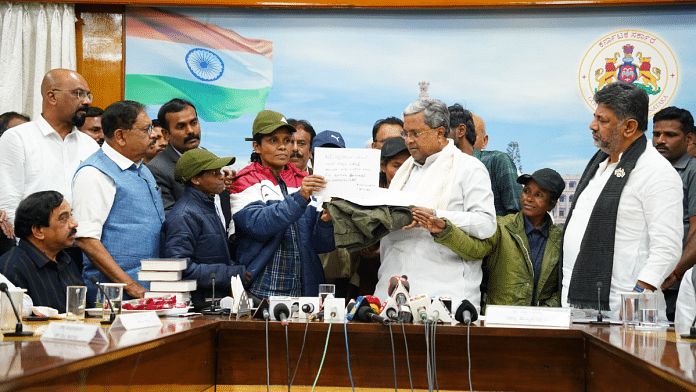
Bengaluru: Six Naxalites, including four women, surrendered before the Karnataka government Wednesday, marking the possible end of an armed struggle that has troubled the southern state for at least the last two decades.
Mundagaru Latha, Sundari Kuthluru, Vanajakshi Balaehole, Mareppa Aroli, K. Vasantha, and T. N. Jeesh surrendered before the police in Chikamagaluru and then taken to Bengaluru to meet with Chief Minister Siddaramaiah.
“…as Ambedkar put it, we have to get justice through constitutional menthods and not unconstitutional methods. They are now convinced that they have to pursued their demands through constitutional methods, not through unconstitutional methods. That is why they they have taken a decision to come to mainstream,” Siddaramaiah told the media.
He added that the demands placed before the government by the Naxals would be looked at sympathetically and discussed in the cabinet before a decision is taken. “If necessary, we will constitute special courts to try and dispose of cases against them as early as possible.”
Earlier, former Naxal Sirimane Nagraj told ThePrint that many had taken up the “struggle to to oppose the inequality and injustice in society”.
“There are no more such people after this batch surrenders. But this is the end of the armed struggle, though it will depend on the government if people with this mindset will also end. Because the main reason we started this struggle was to oppose the inequality and injustice in society,” Sirimane Nagraj, who is also a member of NGO Shantigagi Nagarika Vedike (Citizens for Peace), told ThePrint.
The NGO had facilitated the surrender of this batch of six Naxals.
The Siddaramaiah-led Congress government has tweaked its surrender policy to allow Naxals to lay down their weapons and enter mainstream society.
“With the assurance that the government will accept our demands…and the efforts put in by various organisations, we decided to enter mainstream society. We will stand with the people forever, fight on their behalf and will never back down from this until we breathe,” according to a video by Latha that has been doing the rounds on social media.
After Vikam Gowda alias Vikram Gowdlu’s killing in November last year, there were apprehensions on if the movement was gaining traction after a prolonged period of peace. Police officers directly overseeing the Anti-Naxal Force, too, increased surveillance in the Chikmagaluru region–the epicentre of Karnataka’s Naxal movement and struggle.
“If (the) encounter (had) not happened, they would not have surrendered,” one senior police officer told ThePrint, adding that this was possibly the end of the armed struggle and that there was at least one more such Naxal who is yet to come out of hiding.
The LWE has largely been active in central and eastern India, often seeping into neighbouring states. On Saturday, eight personnel of the District Reserve Guard (DRG) were killed in an improvised explosive device (IED) blast in Chattisgarh’s Bijapur in a suspected Maoist attack. In response, Union Home Minister Amit Shah asserted that the sacrifice of the personnel would not go in vain. “We will end Naxalism in India by March 2026,” he said on ‘X’.
Also Read: CAPF lost twice as many personnel to illness, heart attacks than to combat in Naxal-hit areas in 5 yrs
Naxalism entered Karnataka from neighbouring Andhra Pradesh and was first seen in the border district of Raichur. Later, it spread to Chikmagaluru, as tribal rights and destruction of forests due to large projects became the flashpoint of the struggles.
There have been encounters in which both sides suffered heavy casualties over the years and so were the many cases of torture for extracting information about the cadres.
The 2005 killing of key leader Saket Rajan dealt a blow to the movement in Karnataka that was largely centered around Chikmagaluru and the stretch of Western Ghats. But days later eight policemen were killed in a retaliatory attack in Tumakuru’s Pavagada, intensifying tensions.
The then government led by N.Dharam Singh raised two special forces that combed the Malnad region (Western Ghats) and along the AP border districts to counter the rising LWE activities. Singh had said that he was open to talks only if the Naxals lay down their arms.
Successive governments have attempted to check the LWE activities. In 2010, a surrender policy with certain conditions for those willing to lay down their weapons was introduced.
In December 2014, Sirimane Nagraj and Noor Sreedhar surrendered and then became the bridge between the government and the Naxals. Public personalities such as senior journalist Gauri Lankesh and firebrand politician A.K.Subbiah also helped with the outreach.
“We had simple cases and were withdrawn. In one to two years, the cases were settled. But the ones who came out later (post 2016)…around 12 of them…did not get all the benefits nor any help from the government. They were running from pillar to post, burdened financially by fighting court cases and unable to settle,” Nagraj told ThePrint.
Siddaramaiah has assured to increase financial assistance, provide land and homes, rehabilitation, skill training, deed titles and check the harassment meted out by the forest department against tribals and others living alongside or inside forests, according to Nagraj.
The surrendering Naxals, he said, have also demanded a probe into the “fake” encounter of Vikram Gowda. “We have been assured that a fast track court will also hear our cases and that public prosecutors will not object to our bail.”
(Edited by Tony Rai)
Also Read: In Karnataka, a growing chorus of Congress MLAs criticising guarantee schemes. ‘Impact on development’